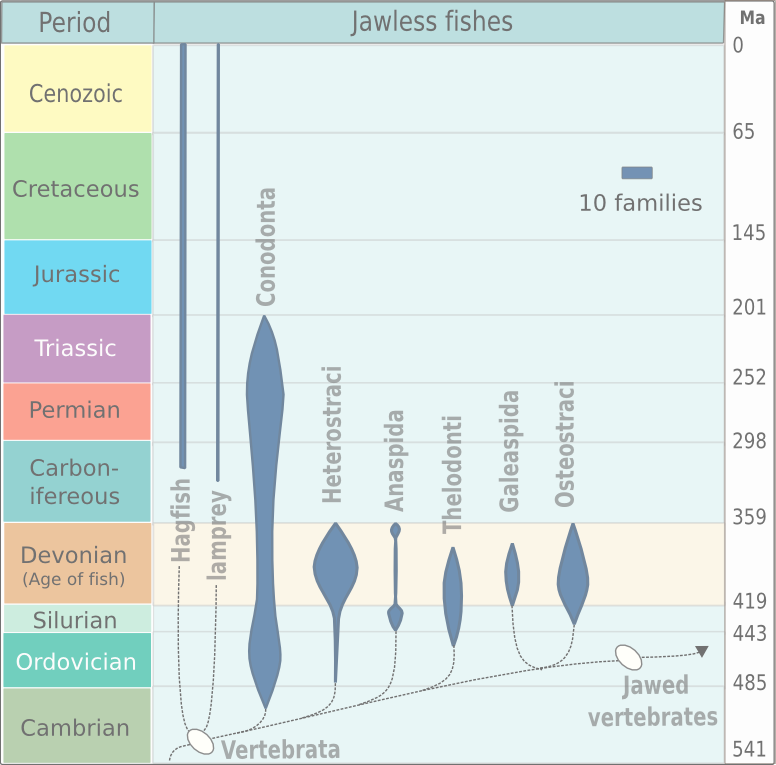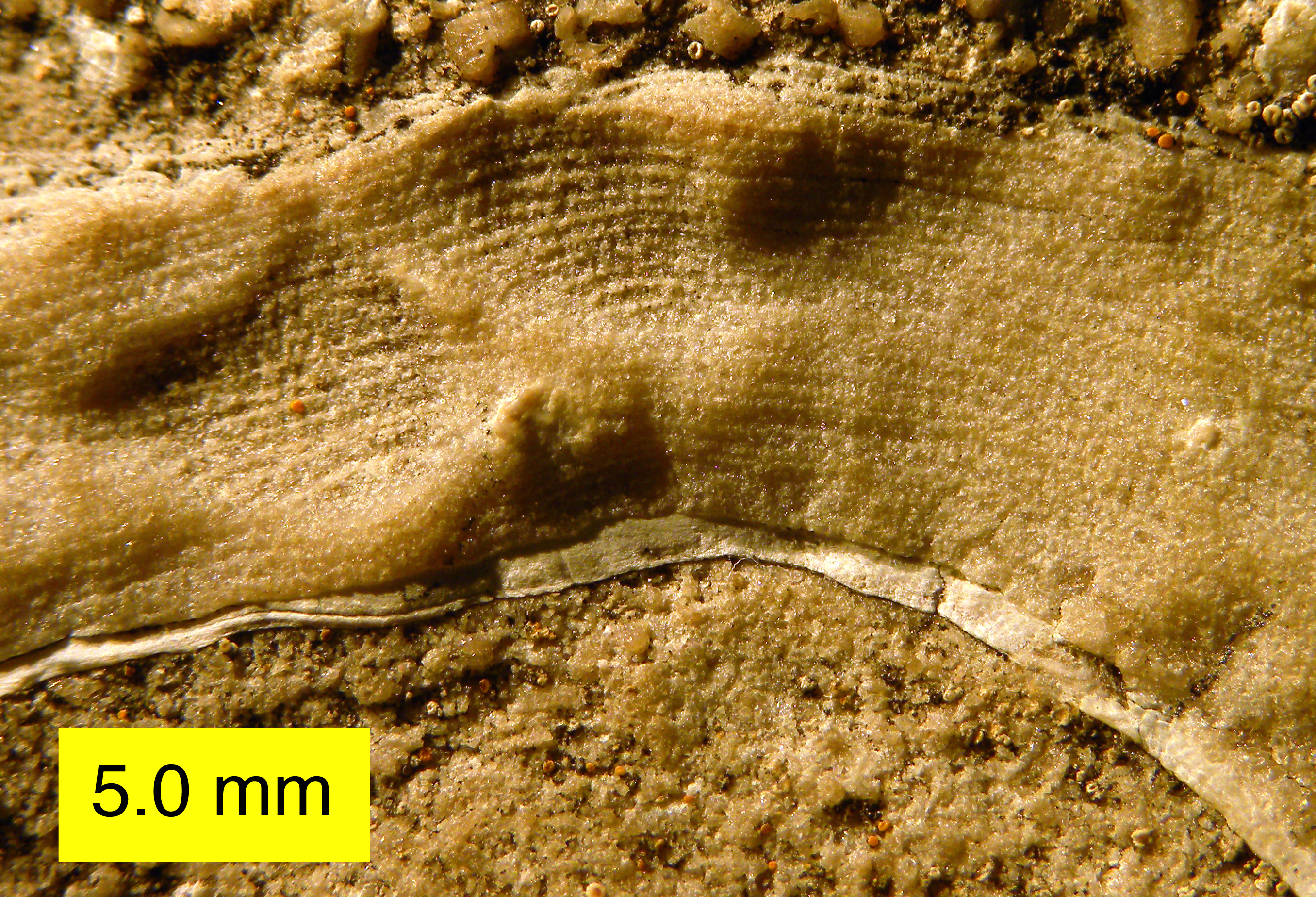|
Thelodonti
Thelodonti (from Greek: "nipple teeth")Maisey, John G., Craig Chesek, and David Miller. Discovering fossil fishes. New York: Holt, 1996. is a class of extinct Palaeozoic jawless fishes with distinctive scales instead of large plates of armor. There is much debate over whether the group represents a monophyletic grouping, or disparate stem groups to the major lines of jawless and jawed fish. Thelodonts are united in possession of " thelodont scales". This defining character is not necessarily a result of shared ancestry, as it may have been evolved independently by different groups. Thus the thelodonts are generally thought to represent a polyphyletic group, although there is no firm agreement on this point. On the basis that they are monophyletic, they are reconstructed as being ancestrally marine and invading freshwater on multiple occasions. "Thelodonts" were morphologically very similar, and probably closely related, to fish of the classes Heterostraci and Anaspida, di ... [...More Info...] [...Related Items...] OR: [Wikipedia] [Google] [Baidu] |
Agnatha
Agnatha (; ) or jawless fish is a paraphyletic infraphylum of animals in the subphylum Vertebrata of the phylum Chordata, characterized by the lack of jaws. The group consists of both extant taxon, living (Cyclostomi, cyclostomes such as hagfishes and lampreys) and Extinction, extinct clades (e.g. conodonts and Cephalaspidomorphi, cephalaspidomorphs, among others). They are sister taxon, sister to vertebrates with jaws known as gnathostomes, who evolution, evolved from jawless ancestors during the early Silurian by developing folding joint, articulations in the first pairs of gill arches. Sequencing, Molecular data, both from rRNA and from mtDNA as well as Embryology, embryological data, strongly supports the hypothesis that both groups of living agnathans, hagfishes and lampreys, are more closely related to each other than to Gnathostomata, jawed fish, forming the Class (biology), superclass Cyclostomi. The oldest fossil agnathans appeared in the Cambrian. Living jawless fish c ... [...More Info...] [...Related Items...] OR: [Wikipedia] [Google] [Baidu] |
Thelodontiformes
Thelodontiformes is an extinct order of jawless fish of the Silurian.Kiaer, J., 1932: New coelolepids from the Upper Silurian on Oesel (Esthonia). Eesti Loodusteaduse Arhiiv, Seeria 1, 10: 167-176. Because the paucity of intact fossils, especially since some families are known entirely from scale fossils, taxonomy of thelodonts is based primarily on scale morphology. A recent assessment of thelodont taxonomy by Wilson and Märss in 2009 merges the order (biology), orders Loganelliiformes, Katoporiida and Shieliiformes into Thelodontiformes, places family (biology), families Lanarkiidae and Nikoliviidae into Furcacaudiformes (because of scale morphology) and establishes Archipelepidiformes as the basal-most order.Wilson, Mark VH, and Tiiu Märss. "Thelodont phylogeny revisited, with inclusion of key scale-based taxa." Estonian Journal of Earth Sciences 58.4 (2009): 297œ310/ref> References External links * Thelodonti Silurian jawless fish Prehistoric jawless fish ... [...More Info...] [...Related Items...] OR: [Wikipedia] [Google] [Baidu] |
Furcacaudiformes
Furcacaudiformes is an extinct order of jawless fish in the class Thelodonti. Because the paucity of intact fossils, especially since some families are known entirely from scale fossils, taxonomy of thelodonts is based primarily on scale morphology. A 2009 assessment of thelodont taxonomy by Wilson and Märss merges the orders Loganelliiformes, Katoporiida and Shieliiformes into Thelodontiformes, places families Lanarkiidae and Nikoliviidae into Furcacaudiformes (because of scale morphology) and establishes Archipelepidiformes Archipelepidiformes is an order of extinct jawless fishes in the class Thelodonti. Archipelepidiforms are regarded as the basalmost thelodonts primarily because the histology and morphology of archipelepidiforms have many similarities with the h ... as the basal-most order. References External links * Thelodonti Devonian jawless fish Prehistoric jawless fish orders {{Devonian-jawless-fish-stub ... [...More Info...] [...Related Items...] OR: [Wikipedia] [Google] [Baidu] |
Archipelepidiformes
Archipelepidiformes is an order of extinct jawless fishes in the class Thelodonti. Archipelepidiforms are regarded as the basalmost thelodonts primarily because the histology and morphology of archipelepidiforms have many similarities with the histology and morphology of pteraspidomorphi, pteraspidomorphs, hinting that the two groups share a common ancestor, and hinting that archipelepidiforms retain many primitive features from this common ancestor.Soehn, K. L., Märss, T., Caldwell, M. W. & Wilson, M. V. H., 2001: New and biostratigraphically useful thelodonts from the Silurian of the Mackenzie Mountains, Northwest Territories, Canada. Journal of Vertebrate Paleontology, 21: 651-65/ref> Wilson, Mark VH, and Tiiu Märss. "Thelodont phylogeny revisited, with inclusion of key scale-based taxa." Estonian Journal of Earth Sciences 58.4 (2009): 297œ310/ref> Currently, only whole body fossils of ''Archipelepis'' are known: these fossils show that archipelepids were tadpole-like anima ... [...More Info...] [...Related Items...] OR: [Wikipedia] [Google] [Baidu] |
Loganellia
''Loganellia'' is a genus of jawless fish which lived between 430 and 370 million years ago, during the Silurian and Devonian periods of the Paleozoic. ''Loganellia'' belonged to the Thelodonti class and like other Thelodonts possessed scales instead of plate armor. ''Loganellia'' are thought to be more closely related to the crown group of gnathostomes than conodonts. They are noted for their denticle whorls - oropharyngeal denticles that lined their branchial bars - which are thought to be homologous with other, later gnathostome teeth. In this sense, ''Loganellia'' may possess the earliest known dental structures related to modern teeth, and would have evolved in the throat, rather than through dermal denticle A fish scale is a small rigid plate that grows out of the skin of a fish. The skin of most jawed fishes is covered with these protective scale (zoology), scales, which can also provide effective Underwater camouflage, camouflage through the us ...s or jaws. Refere ... [...More Info...] [...Related Items...] OR: [Wikipedia] [Google] [Baidu] |
Furcacauda
''Furcacauda'' is a genus of thelodontid agnathan from the Lower Devonian of Canada, and is the type genus of the order Furcacaudiformes Furcacaudiformes is an extinct order of jawless fish in the class Thelodonti. Because the paucity of intact fossils, especially since some families are known entirely from scale fossils, taxonomy of thelodonts is based primarily on scale morphol .... Furcacaudiform thelodontids were deep water jawless vertebrates with symmetrical fork and lobed-finned tails and scales smaller than typical loganellid and nikoliviid thelodonti scales. Furcacaudiform thelodonts are noted as having a laterally compressed body, large anterior eyes, slightly posterior, lateral, and vertical to a small mouth, and a condensed curved row of branchial openings (gills) directly posterior to the eyes. Many but not all had laterally paired fins. Wilson and Caldwell also note the presence of a caudal peduncle and a long caudal fin made of two large lobes, one dorsal and on ... [...More Info...] [...Related Items...] OR: [Wikipedia] [Google] [Baidu] |
Lanarkia
''Lanarkia'' is a genus of extinct thelodont agnathan which existed in what is now Scotland and Canada during the upper Silurian period.''Lanarkia horrida'' at www.fossilmuseum.net. Description Lanarkia were very small fish specifically 30-45 cm in length that would have been possible prey toeurypterids
Eurypterids, often informally called sea scorpions, are a group of extinct marine arthropods that form the order Eurypterida. The earliest known eurypterids date to the Darriwilian stage of the Ordovician period, 467.3 million years ago. The ... .
References [...More Info...] [...Related Items...] OR: [Wikipedia] [Google] [Baidu] |
Heterostraci
Heterostraci (Ancient Greek, ἕτερος+ὄστρακον "those [with] a different shell" [-i is pl. of -us]) is an extinct subclass (biology), subclass of Pteraspidomorphi, pteraspidomorph, ostracoderm, jawless vertebrate that lived primarily in Marine (ocean), marine and estuary environments. Heterostraci existed from the mid-Ordovician to the conclusion of the Devonian. Description and anatomy The heterostracans differed from other Paleozoic agnathan taxa both in the arrangement and histology of their scales. Most heterostracans had two plates which form a large dorsal shield and a large ventral shield, and had series of scales arranged in various patterns on the sides of their bodies, the exact pattern differing from one group to another. In a few primitive forms, such as ''Lepidaspis'', the dorsal and ventral shields are composed of a mosaic of tiny scales. In most other known forms, though, these tiny scales have fused together to form the shield-plates. The scale ... [...More Info...] [...Related Items...] OR: [Wikipedia] [Google] [Baidu] |
Late Devonian Extinction
The Late Devonian mass extinction, also known as the Kellwasser event, was a mass extinction event which occurred around 372 million years ago, at the boundary between the Frasnian and Famennian ages of the Late Devonian period.Racki, 2005McGhee, George R. Jr, 1996. The Late Devonian Mass Extinction: the Frasnian/Famennian Crisis (Columbia University Press) It is placed as one of the "Big Five" most severe mass extinction events in Earth's history, with likely around 40% of marine species going extinct, though the degree of severity is contested. A second mass extinction called the Hangenberg event, also known as the end-Devonian extinction, occurred 13 million years later around 359 million years ago, bringing an end to the Famennian and Devonian, as the world transitioned into the Carboniferous Period. The effects of the two extinction events have historically been conflated, and both events collectively profoundly reshaped marine ecosystems. Although it is well established ... [...More Info...] [...Related Items...] OR: [Wikipedia] [Google] [Baidu] |
Fish Scale
A fish scale is a small rigid plate that grows out of the skin of a fish. The skin of most jawed fishes is covered with these protective scales, which can also provide effective camouflage through the use of reflection and colouration, as well as possible hydrodynamic advantages. The term ''scale'' derives from the Old French , meaning a shell pod or husk. Scales vary enormously in size, shape, structure, and extent, ranging from strong and rigid armour plates in fishes such as shrimpfishes and boxfishes, to microscopic or absent in fishes such as eels and anglerfishes. The morphology (biology), morphology of a scale can be used to identify the species of fish it came from. Scales originated within the jawless ostracoderms, ancestors to all jawed fishes today. Most bony fishes are covered with the cycloid scales of salmon and carp, or the ctenoid scales of perch, or the ganoid scales of sturgeons and gars. Cartilaginous fishes (sharks and rays) are covered with placoi ... [...More Info...] [...Related Items...] OR: [Wikipedia] [Google] [Baidu] |





